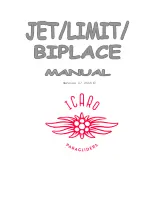Summary of Contents for Travel Air D95A
Page 1: ...eecacrafto Travel Air MODEL OVVNER S MANUAL Secch ûircrah Ûorporation i UJ i ch i i e V i n s ...
Page 2: ......
Page 9: ...13 77 f 25 94 37 82 72 DIAM o I 9 59 3 7 0 VI ...
Page 29: ...CON patSN AN SYSTE ...
Page 80: ...TWO ENGINE TIME TO CLIMB GROSS WElGHT 4200 LBS o Isa i sanil1W GlIYGNVIS 6 6 ...
Page 112: ...LUBRICATION POINTS A BC DE FG 3 13 I I i I ONMLX J IH A C 3 8 0 oo 1 7 14 ...



































